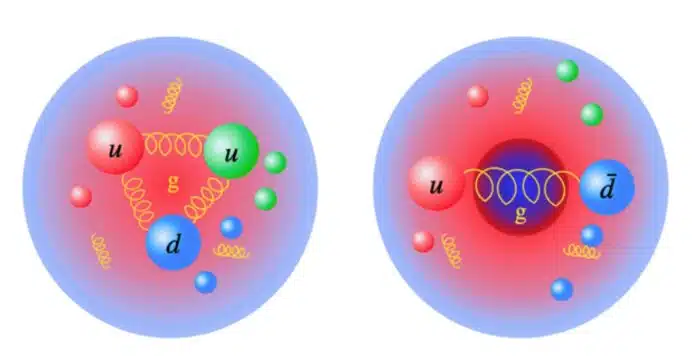
By Amit Malewar 16 Nov, 2024
Collected at: https://www.techexplorist.com/new-insights-how-mass-distributed-hadrons/92961/
The mass of a hadron can be determined by calculating the trace of the energy-momentum tensor within the hadron, which involves the trace anomaly and sigma terms. The trace anomaly, resulting from the breaking of conformal symmetry, is considered a key factor in the generation of hadron mass and the phenomenon of confinement.
In a study published in Physical Review D, scientists calculated the trace anomaly for both nucleons (protons or neutrons) and pions. The results revealed that the pion’s mass distribution closely resembles the charge distribution of the neutron, whereas the nucleon’s mass distribution is more similar to the charge distribution of the proton.
Understanding the origin of nucleon mass is a critical scientific goal of the Electron-Ion Collider (EIC). Researchers aim to unravel how the mass from quarks and gluons is distributed within hadrons, like protons and neutrons, which are held together by a strong force.
Recent calculations show that the mass distribution in hadrons can be determined numerically using first-principle approaches based on fundamental physical laws. This new method will help scientists interpret data from nuclear physics experiments, providing deeper insights into the internal structure of hadrons and the mechanisms that give rise to their mass.
Experiments investigating the origin of nucleon mass are planned for the future Electron-Ion Collider (EIC) at Brookhaven National Laboratory. These experiments will use electron-proton scattering to create heavy states sensitive to the proton’s internal structure, particularly the distribution of gluons.
By analyzing the scattering data, scientists aim to map how the mass of quarks and gluons is distributed within the proton. This process is similar to how X-ray diffraction was used to reveal the double-helix structure of DNA. Theoretical calculations, based on the Standard Model, help guide these experiments by predicting how mass is distributed within hadrons and providing a framework for interpreting the experimental results.
The findings reveal important insights into how mass is distributed within particles such as the pion and nucleon. Specifically, the results suggest that the structure of the pion plays a key role in linking two fundamental aspects of the Standard Model: the existence of an absolute scale (related to mass) and the asymmetry between left-handed and right-handed quantities, which are central to the behavior of fundamental particles and interactions. This connection helps deepen our understanding of the underlying symmetries and mechanisms governing the subatomic world.
Journal Reference:
- Bigeng Wang et al, Trace anomaly form factors from lattice QCD, Physical Review D (2024). DOI: 10.1103/PhysRevD.109.094504

Leave a Reply